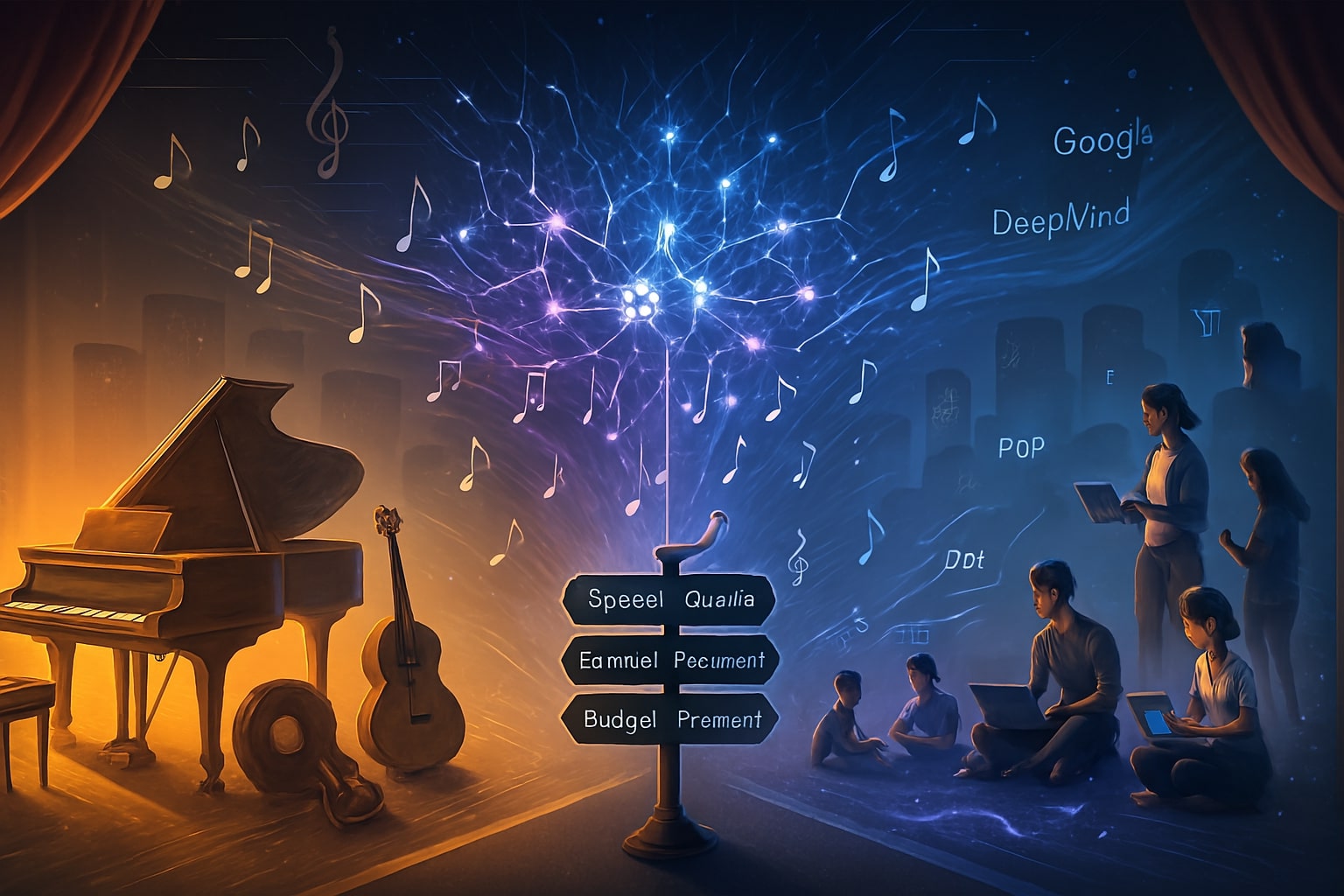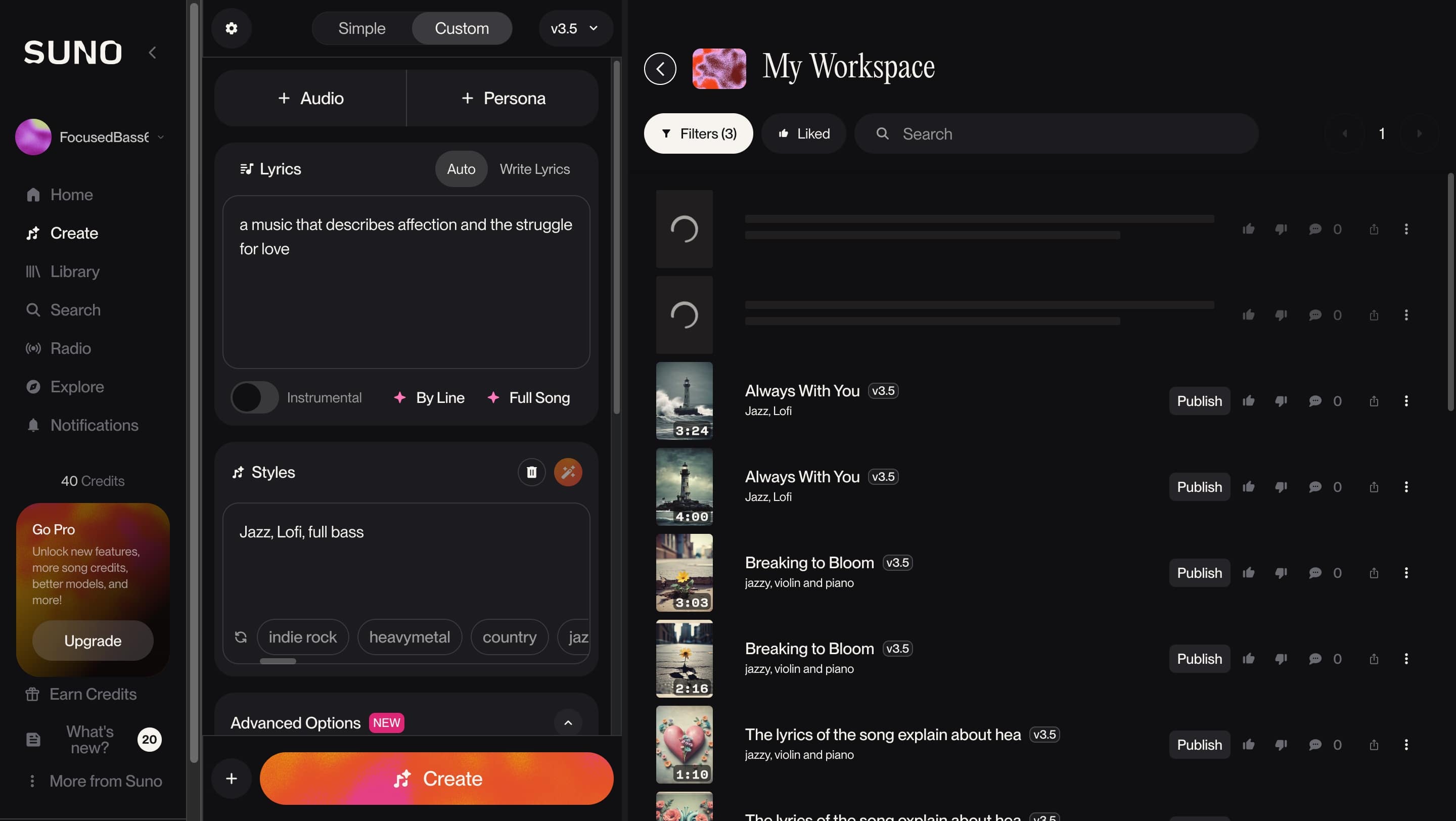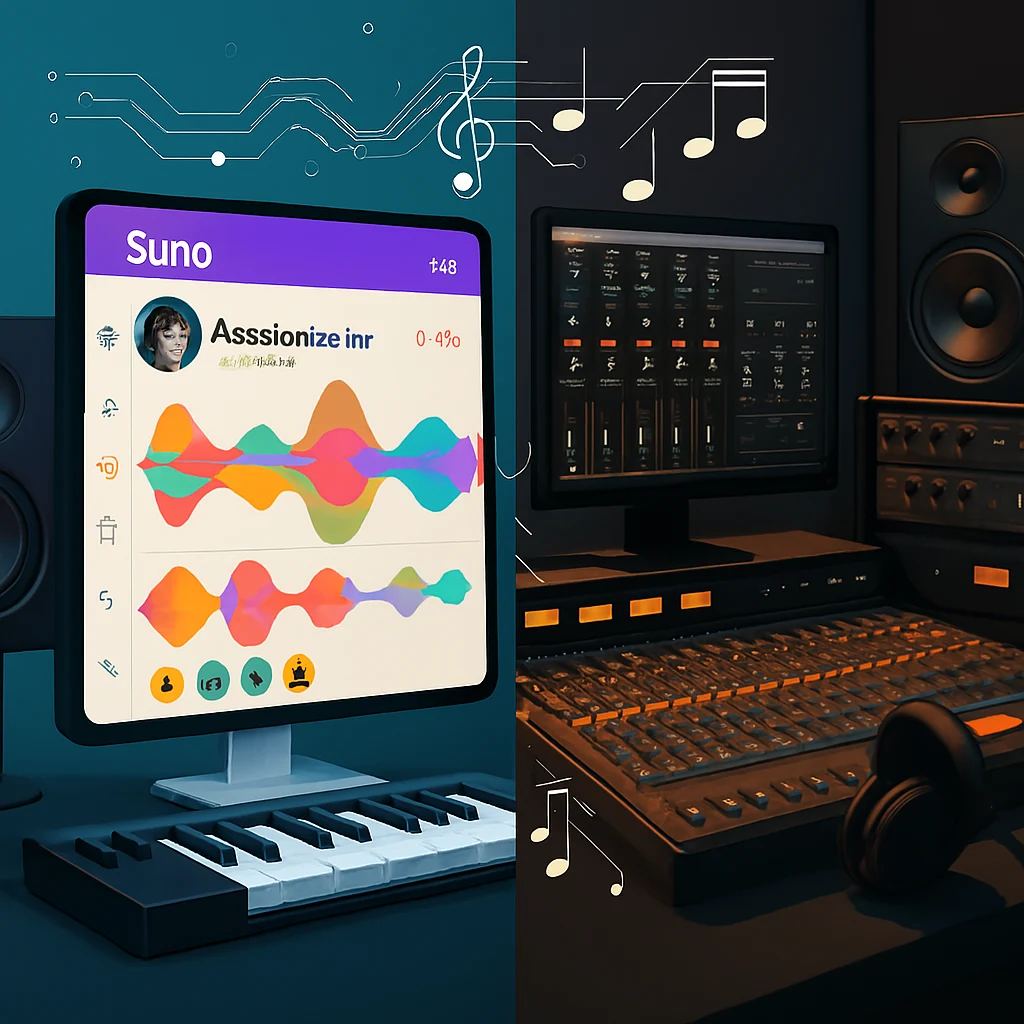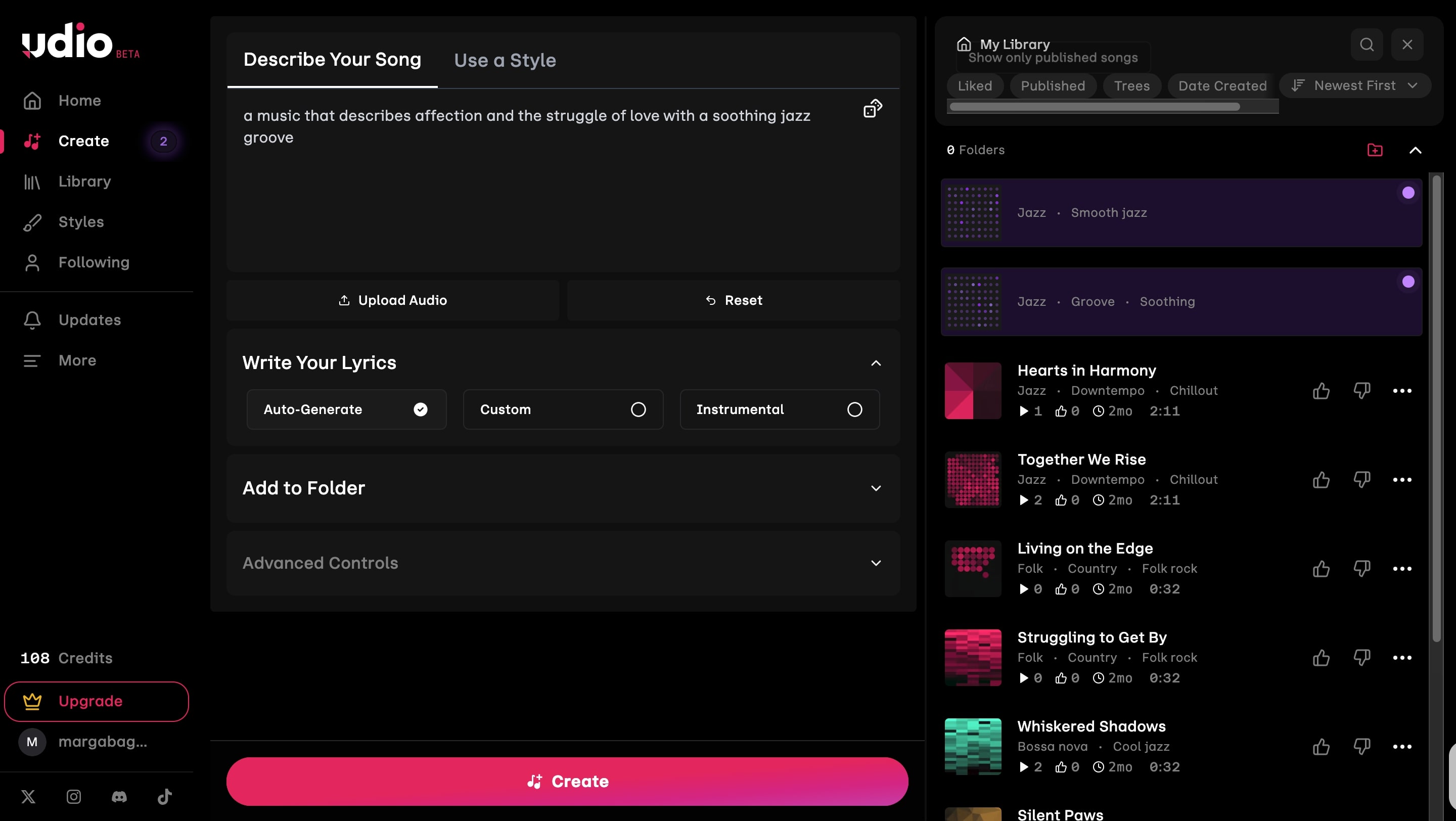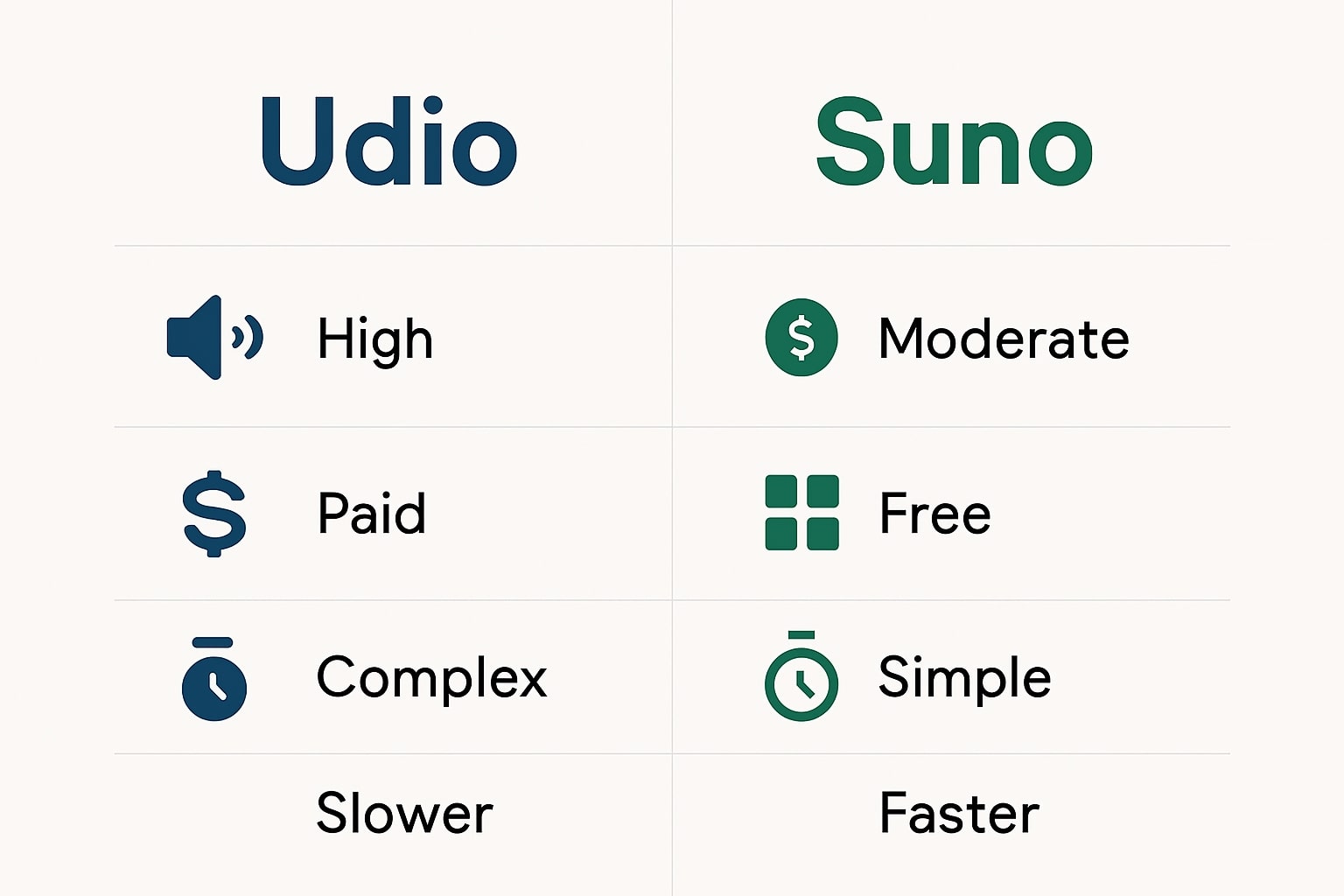|
FEATURE
|
SUNO
|
UDIO
|
|
Latest Version
|
v4.6 (Aug 2025)
|
v2.4 (Sept 2025)
|
|
Best For
|
Speed, versatility, content music
|
Audio quality, professional use
|
|
Vocal Quality
|
Lifelike, expressive
|
Crisp, powerful, genre-accurate
|
|
Instrumentation
|
Good, genre-blending
|
Superior, especially rock/metal
|
|
Stem Export
|
Available on Pro and Premier tiers
|
Available on Standard and higher
|
|
DAW Integration
|
Not available
|
Available for Ableton, FL Studio, Logic Pro
|
|
Voice Reference
|
Not available
|
Available (10-second upload for original vocal style)
|
|
Lyric Refinement
|
Not available
|
Available (AI adjusts melody to new lyrics)
|
|
Generation Speed
|
3–6 minutes
|
11–20 minutes
|
|
Pricing (Monthly)
|
Pro: $8, Premier: $24
|
Standard: $12, Pro: $25
|
|
Free Tier
|
500 credits per month
|
500 credits per month
|
|
Commercial License
|
Available on Pro and higher
|
Available on Standard and higher, with guarantee
|
|
Legal Safety
|
Medium
|
High
|
Budget tip: track credits per finished asset for a week in each tool. Choose a tier that covers your peak week, not your average.
Suno Pricing Structure
Suno offers transparent, tiered pricing designed to scale with user needs. The Basic Plan is an excellent choice for those new to AI music generation or those who want to explore Suno AI’s capabilities without any financial commitment.
Current Suno Pricing (2025):
- Basic (Free): Limited daily credits, non-commercial terms
- Pro Plan: $8/month (billed annually), 2,500 credits monthly, general commercial terms
- Premier Plan: $24/month (billed annually), 10,000 credits monthly, advanced features including stem separation
For enterprise users or those with high-volume music generation needs, Suno AI offers customizable credit amounts, commercial terms, and additional top-ups.
Udio Pricing Model
Udio maintains a different pricing approach, currently operating in beta with generous free access. Udio is currently available as a free beta. This gives users a generous number of credits to generate music, although specific long-term pricing plans have not yet been announced.
Udio (Exited Beta)
- Free: $0, 500 credits/month, non-commercial use
- Standard: $12/month, 3,000 credits, stem export, DAW plugin, voice reference
- Pro: $25/month, 10,000 credits, commercial guarantee, team workspace, priority generation
Early reports suggest paid plans will start around $25/month, positioning Udio between Suno’s Pro and Premier tiers. This pricing reflects Udio’s focus on professional users who require higher-quality output and advanced features.
Genre Specialization and Creative Capabilities
Suno’s Versatility Advantage
Key features include support for over 1,200 musical genres and seamless mashups, improved vocal expressiveness with natural phrasing and vibrato, and longer track generation (up to 8 minutes). This extensive genre support makes Suno incredibly versatile for content creators working across different niches.
The platform particularly excels at pop, electronic, and mainstream genres. Ever wanted to try your hand at EDM or classical music but didn’t know where to start? Suno’s genre versatility allows you to experiment without needing deep expertise.
Udio’s Professional Focus
While Udio supports fewer genres, it delivers superior results in specific categories. Rock and Metal Enthusiasts: Udio excels in these genres with detailed and high-quality outputs. Professional musicians working in complex genres often prefer Udio’s nuanced approach to composition.
Here the music composition by Udio is again a better fit genre-wise along with clearer vocals, particularly in genres requiring sophisticated harmonic structures and dynamic arrangements.
Legal Considerations and Copyright Issues
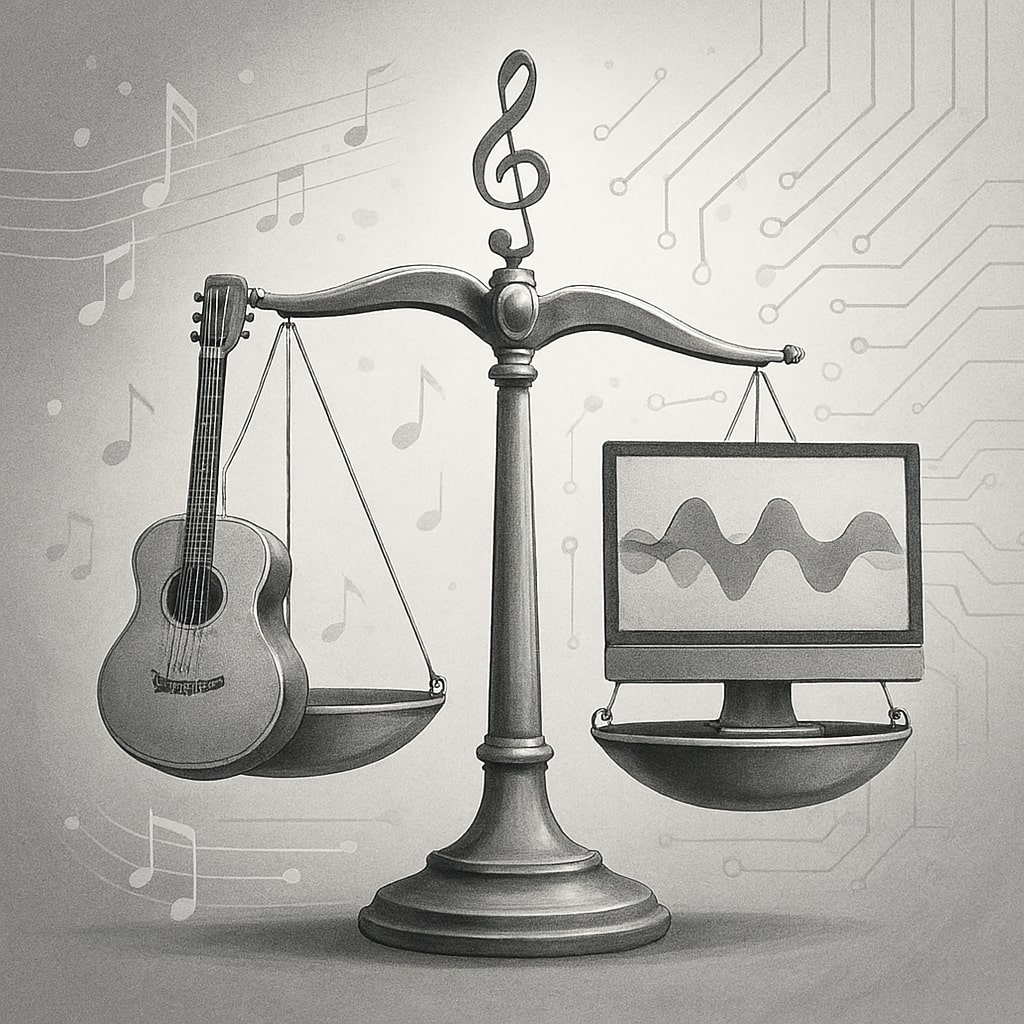
Image create with Microsoft Copilot.
The legal landscape surrounding AI music generation has become increasingly complex in 2025. Both platforms face significant challenges that users must understand.
The RIAA Lawsuits
WASHINGTON, DC (June 24, 2024) – The Recording Industry Association of America® (RIAA) today announced the filing of two copyright infringement cases based on the mass infringement of copyrighted sound recordings copied and exploited without permission by two multi-million-dollar music generation services, Suno and Udio.
The lawsuits allege that both platforms trained their AI models on copyrighted music without permission. Suno admitted in a court filing on Thursday that it did, in fact, train its AI model using copyrighted songs. But it claimed that doing so was legal under the fair-use doctrine.
Industry Response and Fair Use Claims
Suno CEO and co-founder Mikey Shulman continued on in a blog post published the same day as the legal filing, saying “We train our models on medium- and high-quality music we can find on the open internet… Much of the open internet indeed contains copyrighted materials, and some of it is owned by major record labels”. As of 2025, Suno has introduced a “Copyright Shield” on its Premier tier, where Suno assumes legal liability for false claims if users follow content guidelines.
As of August 2025, Udio transitioned to a “Clean Training Set v2” — removing all RIAA-represented content. It now trains only on independent artists, Creative Commons, and licensed music.
Udio also launched a “Commercial Guarantee” on its Pro tier: if a user receives a false copyright claim, Udio will cover the associated penalties.
Key Insight: Udio is now the safer choice for commercial projects. Suno remains popular, but creators must be more cautious about output similarity to existing hits.
Professional Use Cases and Industry Applications
Content Creation and Marketing
Both platforms serve the booming content creation industry, but with different strengths. Suno’s rapid generation capabilities make it ideal for social media content, podcast intros, and background music for videos. For background scores, Suno and Soundverse are great options. Suno adapts to themes, while Soundverse adds immersive spatial audio. Use them for films, YouTube videos, or gaming projects.
Udio’s superior audio quality makes it better suited for professional productions where audio fidelity matters. Independent filmmakers, advertising agencies, and production companies often prefer Udio despite longer generation times.
Music Industry Professional Adoption
Musicians are increasingly bringing generative AI into their creative process. Professional composer Eric Lyon’s experiment demonstrates how these tools can inspire human creativity: “The cheerfulness of the music and text was completely incongruous for the subject of nuclear war,” said Lyon to the Washington Post.
This unpredictability can spark creative breakthroughs, but it requires platforms sophisticated enough to handle complex musical concepts, where Udio often outperforms Suno.
Collaborative Features and Workflow Integration
Suno also integrates community features, such as direct access to Discord, fostering interaction and collaboration among users. This social aspect helps creators discover new techniques and share inspiration.
The platform’s recent addition of playlist-based generation allows users to create cohesive musical collections, essential for content creators managing multiple projects simultaneously.
For example, Udio shines in collaborative settings by making it easy for multiple users to work on the same project. These features cater to professional teams working on complex projects requiring multiple iterations and stakeholder input.
Udio’s advanced editing capabilities, including detailed remixing and song extensions, provide the granular control professional workflows demand.
Practical Usage Guide: Prompt Examples and Best Practices
Understanding how to effectively use each platform requires examining their prompt systems and generation approaches. Both platforms use text-to-music generation, but their prompt handling and output styles differ significantly.
Suno Prompt Examples and Workflow
Suno excels with straightforward, descriptive prompts that anyone can master quickly. The platform offers both Simple Mode for beginners and Custom Mode for advanced users.
Basic Prompt Structure:
"Upbeat electronic dance music with heavy bass and energetic vocals about summer nights"
Advanced Custom Mode Example:
Genre: "Future Bass, Electronic, Energetic"
Lyrics: [Custom lyrics or auto-generate]
Mood: "Uplifting, Party, High-energy"
Instruments: "Synthesizers, Heavy Bass, Electronic Drums"
Content Creator Example:
"Calm acoustic guitar background music for YouTube videos, instrumental only, 3 minutes, no vocals, gentle and warm"
Professional Marketing Example:
"Corporate motivational background track, piano and strings, inspiring and uplifting, suitable for business presentations"
Pop ballad vocal
intimate female vocal, modern pop ballad, 90–120 seconds, soft piano + warm pads, subtle live drums, rich chorus harmonies, clear diction, radio‑friendly, cinematic lift in last chorus, clean mix, gentle plate
Corporate instrumental
uplifting corporate underscore, 90 seconds, electric piano + palm‑mute guitar + light percussion, bright and optimistic, edit points every 8 bars, sting ending at 0:28 and 0:58Suno's strength lies in understanding natural language descriptions and quickly generating usable results. The platform automatically suggests genre tags and styles, making it accessible for users without deep musical knowledge.
Udio Prompt Examples and Advanced Techniques
Udio requires more sophisticated prompting but rewards users with higher-quality, more nuanced output. The platform excels when users provide detailed musical context and specific stylistic guidance.
Professional Rock Example:
"Hard rock song with powerful drums, bluesy guitar riffs, raw male vocals, lyrics about overcoming challenges, Led Zeppelin influenced, dynamic tempo changes"
Classical Composition Example:
"Orchestral piece in D minor, dramatic strings section, French horn melody, cinematic and emotional, suitable for film score, 4/4 time signature"
Electronic Producer Example:
"Deep house track, 128 BPM, analog synthesizer leads, filtered bass line, minimal vocals, underground club atmosphere, progressive structure"
Jazz Fusion Example:
"Jazz fusion instrumental, complex chord progressions, saxophone lead, electric guitar comping, syncopated rhythm section, modal harmony"
Udio – Indie folk vocal
indie folk, intimate lead vocal, fingerpicked acoustic + cello swells, 80–95 BPM, verse–chorus form, airy backing harmonies in chorus, natural room reverb, warm tape feel
Udio – Cinematic build
inematic underscore, evolving texture, low strings ostinato, felt piano, subtle synth pulses, crescendos every 16 bars, ends with soft resolution, no vocals
Tip: reference eras/production traits instead of specific copyrighted songs; describe timbre, space, and arrangement.
Below the prompt box, Udio will often suggest tags as starting points to click and refine the style and direction of your song. This collaborative approach between user input and AI suggestions often produces more sophisticated results.
For Suno Success:
- Use clear, simple language describing mood and energy
- Specify intended use case (background music, social media, etc.)
- Leverage the platform’s genre suggestions and trending styles
- Experiment with the 1,200+ available genre combinations
- Utilize the extend feature for longer compositions
For Udio Excellence:
- Include specific musical terminology and technical details
- Reference musical styles, artists, or eras for context (without direct copying)
- Specify instrumentation and arrangement preferences
- Use the remix and extend features for iterative refinement
- Take advantage of the collaborative editing tools
Workflow Comparison: Speed vs. Quality
Suno Workflow (Speed-Optimized):
- Enter basic prompt (30 seconds)
- Select from auto-generated options (1 minute)
- Extend or modify as needed (2-5 minutes)
- Total time: 3-6 minutes for complete track
Udio Workflow (Quality-Focused):
- Craft detailed prompt with technical specifications (2-3 minutes)
- Review and refine suggested tags (1-2 minutes)
- Generate and evaluate initial output (3-5 minutes)
- Use remix/extend features for perfection (5-10 minutes)
- Total time: 11-20 minutes for polished result
Independent testing reveals clear performance differences between platforms. Here’s what happens when the two leading lyric-based AI music generators are put to the test in a 7-round battle.
Quality Consistency
From the multitudinous examples given above, we can see that Udio has high fidelity and genre-specific music with clear and loud vocals, but it may lack a bit in instrumentation, coherence of the track as well as the overall quality of the song, all these, we believe Suno does better.
This suggests that while Udio excels in specific areas like vocal quality, Suno provides more consistent overall track composition.
Testing across different genres reveals each platform’s specializations. I got much better results with rock music than with classical. For the lyrics, I used Suno’s built-in lyric generator, indicating that genre choice significantly impacts output quality on both platforms.
Suno’s Roadmap
The update also introduces smart prompting tools, stem editing, and remastering options to refine or extend older tracks. Suno’s commitment to continuous improvement ensures users benefit from regular feature updates and quality enhancements.
The platform’s focus on democratizing music creation suggests future updates will prioritize accessibility and ease of use while maintaining professional capabilities.
Udio’s Professional Focus
As Udio transitions from beta to full release, expect pricing structure clarification and enhanced professional features. The platform’s emphasis on audio quality and professional workflows suggests future development will cater increasingly to industry professionals.
Making the Right Choice: Decision Framework
Choose Suno If You:
- Need quick music generation for content creation
- Prefer user-friendly interfaces and community features
- Work across multiple genres and need versatility
- Operate on limited budgets with clear pricing expectations
- Value rapid prototyping over perfect audio quality
Choose Udio If You:
- Prioritize audio quality and professional sound
- Work primarily in rock, metal, or complex genres
- Need advanced editing and remixing capabilities
- Can invest time in learning more complex workflows
- Require superior vocal generation quality
Industry Expert Perspectives
Music industry professionals offer nuanced views on AI music generation. His example demonstrates how composers can use the quirks of generative programs as a springboard for their creative process. This perspective suggests that both platforms serve as creative catalysts rather than replacements for human creativity.
The key lies in understanding each platform’s strengths and limitations, then integrating them appropriately into creative workflows.
The Bottom Line: Strategic Recommendations for 2025

Image create with Microsoft Copilot.
The choice between Udio and Suno ultimately depends on your specific needs, budget, and creative goals. Suno offers unmatched accessibility and versatility, making it ideal for content creators, marketers, and casual musicians who need reliable results quickly. Its transparent pricing and extensive genre support provide excellent value for diverse creative projects.
Udio caters to users prioritizing audio quality and professional output. Despite longer generation times and more complex workflows, it delivers superior results for projects where audio fidelity matters most. The platform’s beta status offers generous free access, but future pricing may limit accessibility for casual users.
Both platforms face significant legal challenges that could impact their long-term viability. Users must weigh these risks against the immediate creative benefits each platform provides. As the AI music landscape continues evolving, staying informed about legal developments and platform updates becomes essential for making strategic creative technology investments.
For most content creators and businesses, Suno’s combination of speed, affordability, and versatility makes it the practical choice. However, if audio quality and professional polish are paramount, Udio’s superior output justifies its complexity and potential higher costs. The future belongs to creators who understand how to leverage both platforms’ unique strengths while navigating the evolving legal and technological landscape.
- RIAA Press Release, June 24, 2024
- Suno Blog: “Our Approach to Training Data”, August 2025
- Udio Official Announcement: “Clean Training Set v2”, August 2025
- TechCrunch: “Udio Exits Beta with Pro Features”, September 2025
- Music Ally: “AI Music in Advertising”, August 2025
- Independent Testing: Arts Management & Technology Lab, September 2025
- User Survey: Tom’s Guide, July–August 2025
